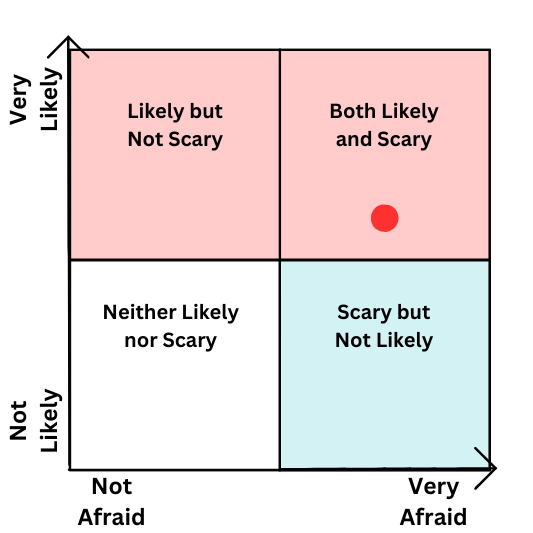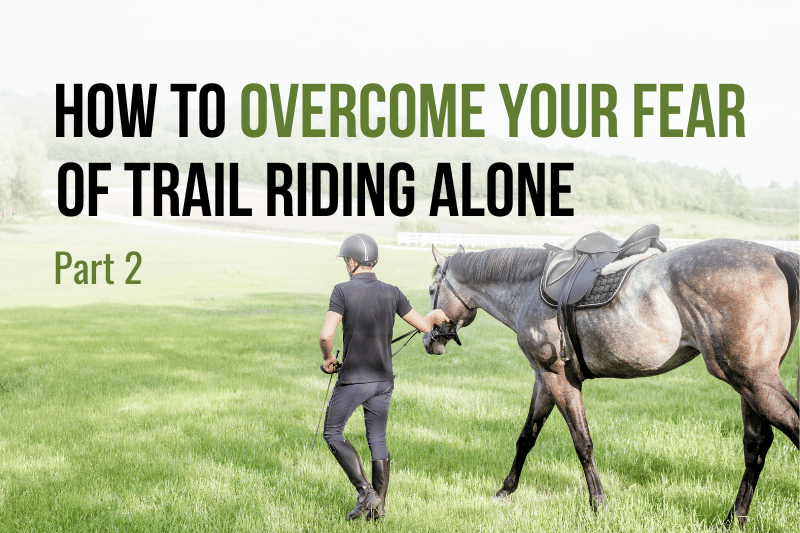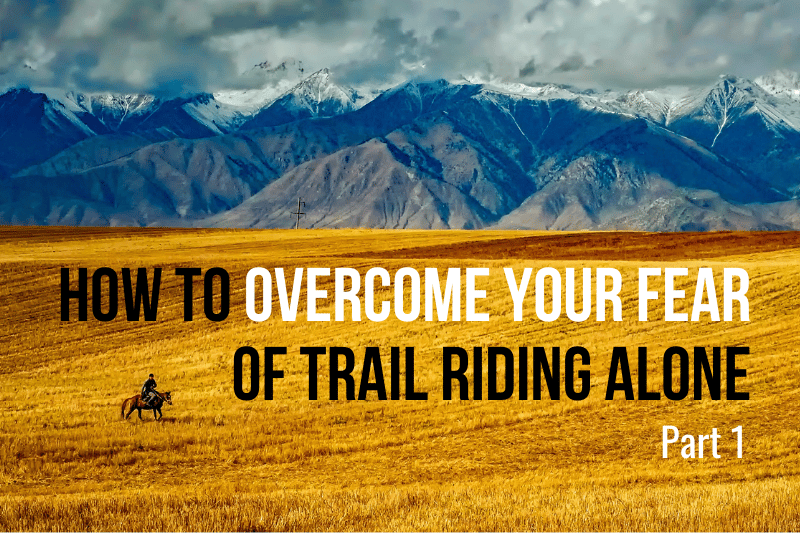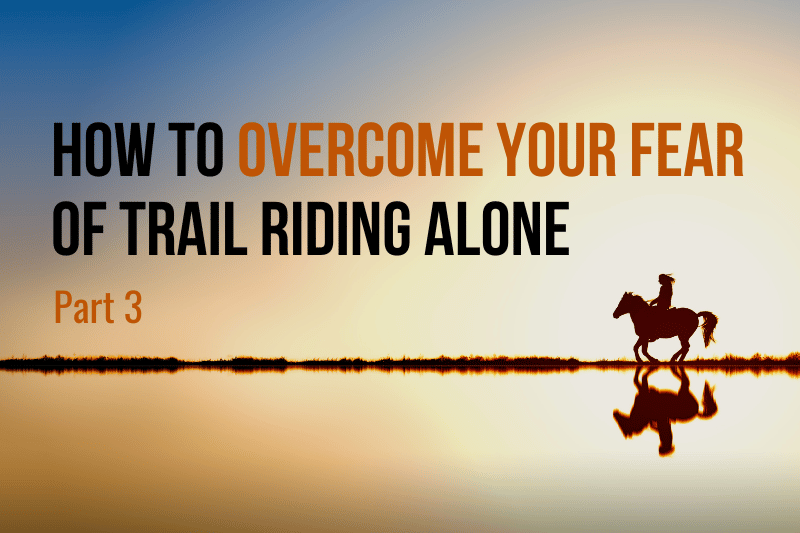Welcome back to the Overcoming Your Fear of Trail Riding Alone series. We’re exploring the answer to a reader question from an aspiring endurance rider. Sara asked:
Can you talk more about getting over fear? I want to try endurance riding but I work weekends, so I’d have to do most of my training rides by myself during the week. The problem is that I’m terrified of trail riding alone!
In Part 1 of this series, you honed in on exactly what scares you about trail riding alone. You placed that fear on a chart based on your fear level and the likelihood of it actually happening. That helped you pinpoint whether your solution will primarily require a practical focus or a psychological focus.
This post explores practical solutions for addressing fear of trail riding alone.
Practical Solutions for Fear of Trail Riding Alone
Grab that paper where you wrote down your specific fear during Part 1.
My own example was: I’m afraid that Bruce (my rescue horse who bucked a few people off before I got him) will buck me off and I’ll get hurt.
The red dot shows where I placed my specific fear on the chart:

Did your specific fear also land in the upper right quadrant? Let’s talk about how to deal with it.
By the way: If you landed in the upper left (Likely but Not Scary), you should still take these practical steps. Although your fear level isn’t sky high, some future rider’s may be. We owe it to our horses and fellow equestrians to minimize everyone’s risk.
You can’t meditate your way out of rational fears — nor should you. Rational fears need to be addressed by changing the facts.
Look at the specific fear you’ve written down. What fact would have to change for that fear to diminish?
- I’d be confident backing my horse trailer.
- I’d know how to change a tire.
- My horse wouldn’t jig.
- My horse would cross water.
- My horse would stand for mounting.
- My horse would be less spooky.
- I’d be confident that I could stick a spin.
- I’d be able to mount from the ground.
- I’d know how to help if my horse got hurt.
In my case, I’d be confident that Brick wouldn’t resort to his old bucking habit in a tense situation.
The good news is that, in most cases, those facts can be changed by training your horse, yourself, or both. The bad news is that it will take time and effort – possibly a significant amount.
Let’s start with the horse.
Train Your Horse
Does your fear stem from your horse’s behavior (or anticipated behavior, as with me and Bruce)?
Some horses are prone to whirling or bolting when spooked. Others refuse to go forward, even resorting to bucking or rearing. Many have annoying habits, like not standing for mounting or refusing to cross water, that don’t really matter at home but become a real problem when you’re alone on the trail.
Like thistles in the pasture, these training gaps are are easily ignored when they’re young, but they can grow into impenetrable barriers. If you want to trail ride alone with confidence, it’s time to pull those weeds.
Depending on your fear level and training ability, you may want to enlist a good trainer to help get your horse to a point where you feel comfortable proceeding. Or perhaps you just need to commit to putting the training time in on your own.
Break the Training Into Comfortable Steps
Personally, I find that I can work through most behavioral problems by breaking them down into steps that both the horse and I are comfortable with. “If it isn’t easy,” I often say, “It isn’t time.”
If I feel the fear rise, I know I need to scale back to a manageable prerequisite that will move us in the right direction.
I also find that when the environment changes (say, from arena to trailhead), I need to go back and repeat earlier steps. This might mean hauling to the trailhead and just training near the trailer, then going home instead of actually conditioning.
Boring? Maybe. But it’s worth it to have a solid horse that you can fully enjoy.
Put More Tools in Your Toolbox
I never ride a horse out of the arena until it has a few skills down pat. These skills are tools I can pull out in a heartbeat if something starts to go sideways. My basic toolbox includes:
- A rock-solid single rein stop with hindquarter disengagement
- A responsive bend on a tight circle
- Lots of groundwork options including sending, backing, and walking figure-8s because I frequently dismount to work through touchy moments on the trail
I teach these skills in the arena until both the horse and I can do them on autopilot. When I head out on the trail, I keep right on drilling them until I’m confident they’ll carry over in a tense situation.
Finally, although it’s not my favorite task, I practice riding my horses in undesirable conditions (like wind, rain, and slick footing) at home so it’s not novel when we encounter those conditions alone on the trail.
Do the Work When and Where It's Needed
Some issues are hard to work on at home because they simply don’t happen there. As frustrating as it is, you may have to sacrifice many trail rides – and even paid events – to focus on training.
I face this with Ledger, who is generally pretty reliable until we get to an endurance ride. (You might recall our adventure at last year’s Owyhee Tough Sucker.) The trick is to let go of any objective beyond dealing with the issue at hand.
To manage your fear while training in a real-deal situation, you may have to do a lot of groundwork. A horse that is fine at home but anxious when alone on the trail almost always benefits from handwalking.
There is no shame in getting off, either during conditioning or at a ride. Handwalking gives you a safe opportunity to see how your horse will react to everything from quail fly-ups to cars. He can work through his nerves while you build your relationship and some extra fitness to boot.
This is the stage I’m at with Bruce: Applying our toolkit in new situations, and getting off as needed to keep everybody safe. It’s a lot of work, but the potential payoff is worth it.
Hey, rider! Would first responders, friends, or strangers know how to help if you were injured around the stable or on the trail? My free I.C.E. Pack includes printable placards for barn and trailer, cards for rider and horse, and instructions for friends and family. Get yours now.
Train Yourself
If it’s your own skill that needs improvement, that’s great news! Whether the ability you need to ride alone with confidence is mental or physical, you can acquire it.
Learn New Skills
Are you afraid to ride alone because you feel unprepared to deal with a potential problem like an injured horse or tight parking space? You can study equine first aid or recruit someone to teach you how to maneuver your trailer. (I made friends with a local CDL instructor who kindly gave me a lesson in trailer backing. Game changer!)
Maybe you’re worried about wild animals and need to educate yourself about critters in your area and their natural behavior. For a fun and informative take on avoiding animal attacks, check out Tooth and Claw podcast.
If you’re not confident in your riding ability, this is a good time to invest in some lessons. Work on improving your seat and pick up some skills for dealing with dicey behavior. If it feels better to you, see if you can borrow a mellower horse when you first start taking those new skills out on the trail.
An instructor can also help you determine whether the horse you have is the right one for you at this point in your journey.
The low point in my own journey through fear was selling a gorgeous mare with a rearing problem that I didn’t feel equipped to solve. If I had that same horse now, I think I’d be more willing to work her through it…but we weren’t a good fit at the time, and that’s okay.
Improve Your Physical Fitness
Are you afraid of being unable to walk out if your horse dumps you miles from the trailer? Do you struggle to mount from the ground? Could you do an emergency dismount if your horse were to bolt?
Physical limitations can put a real damper on confidence when it comes to trail riding alone. The good news is that they can almost always be improved upon.
If you’re hampered by pain or limited mobility, you might be surprised by how much the right medical care, physical therapy, and increased fitness can help. As an equestrian athlete who remains pasted together by a handful of sports medicine professionals, I would encourage you to seek help for physical limitations. It’ll cost time and money, but it could change your life.
What about plain old fitness?
In this excellent post, Jec Aristotle Ballou writes that rider fitness “does NOT mean a marathoner’s level of cardiovascular fitness nor being the skinniest person in the room. For most equestrian disciplines, the cardio demands are low to moderate…Motor control and strength, however, are non-negotiable. If you are going to help your horse use the orchestra of all his muscle groups well, you need to maintain your own.”
Indeed, a horse well-ridden is less likely to stumble on the trail, possibly hurting himself or you.
If you do find yourself injured and alone, being strong could help you self-rescue. As Mark Rippetoe used to say, “Strong people are harder to kill than weak people, and more useful in general.”
For ambitious trail riders, there’s an argument to be made for sufficient cardiovascular endurance to walk over hill and dale to the trailhead if your horse heads that way without you. (Ask me how I know.)
If this is an area you want to work on, check out my recommendations in 5 Reasons Equestrian Athletes Should Use Professional Fitness Programs.
You might also want to read Achieving Rider Fitness When You Don’t Have Time Part 1 and Part 2.
For most people, three strength training sessions per week plus at least a couple hours of zone 2 cardio (which is basically working at about 75% of your max heart rate) is a good place to start.
For bonus points, go hiking or jogging with your horse in-hand to gain even more mental and physical benefit for both partners.
Solid training for your horse, your brain, and your body may be all you need to hit the trail with confidence. However, most of us need to prepare ourselves psychologically as well. The next post in this series explores strategies for that part of the equation. After that, we’ll dig into safety measures every trail rider should consider.
Afraid you’ll miss out? Join my newsletter and get notified of new posts!



